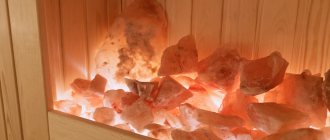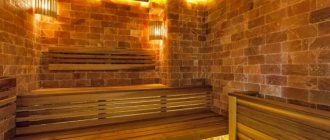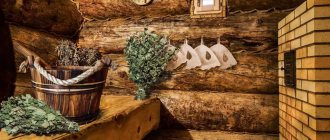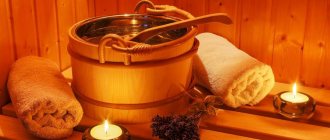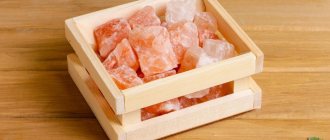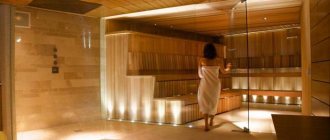Himalayan salt is a product that has been known for hundreds of years. Fans of oriental health traditions believe that it is extremely beneficial for health.
The use of salt was recorded in medieval treatises on Ayurvedic medicine. At that time it was considered a very effective remedy for many diseases.
Fans of a healthy lifestyle use this salt in their food instead of regular salt.
But more often in Russia, Himalayan salt is used for finishing saunas.
What is Himalayan salt
Rock salt (any) is a sedimentary rock. Those who remembered this while studying at school are skeptical about the term itself - the Himalayas are somehow not associated with minerals of this kind.
But skepticism is in vain. Firstly, the largest salt deposits are located in eastern Pakistan, that is, not in the heart of the Himalayas.
Secondly, salt deposits are layers of sedimentary rocks tightly compressed by the movement of tectonic plates.
As a result of volcanic activity, salt was saturated with various elements, which determined its value.
Composition of Himalayan salt
The main component of Himalayan salt is the familiar and well-known sodium chloride - kitchen salt. However, in table salt its content is 99%, and in Himalayan salt it is approximately 95%.
The rest is made up of a variety of elements - in total there are up to 84 types of them in the composition of salt.
In addition to sodium, salt contains potassium, phosphorus, iodine, magnesium, copper, calcium and many other substances.
This mineral wealth explains the popularity of Himalayan salt.
Why is it needed?
In a bathhouse, the body finds itself in extreme conditions.
Heat and high humidity force all organs to work harder. The cardiovascular system begins to react first: blood flow increases, blood vessels dilate, pressure decreases, and the heart begins to beat faster. And then the body releases fluid in the form of sweat to cool itself. In just 20 minutes of staying in the steam room, a person can lose up to 1 liter of water. But this water is not distilled, but its own, internal, containing substances important for health: 0.4-0.8 g of potassium, 2-3 g of sodium chloride, 0.2-0.4 g of magnesium (per 1 l) It is at this moment that it is especially important to restore the body’s water-salt balance
Forms of release of Himalayan salt
Salt comes on sale mainly in two forms: individual, relatively small or medium-sized crystals and large blocks of different sizes. This is done for the convenience of using salt in different areas.
Small crystals are intended for use in food and cosmetology (for baths, scrubs, rubdowns...). They are also used for some types of massage (slightly moistened with water).
Large forms are used in interiors. They are usually used in baths, but sometimes they also decorate fireplaces or are simply used as decorative elements.
Salt for interior decoration is produced in the form of cubes, bricks, tiles, blocks and panels. The purposes of many of these forms are quite similar.
Bricks and blocks are used in walls. They are held together using a special adhesive.
The tile is used as a facing material.
Cubes are the basis for the formation of decorative panels and installations. On their basis, ready-made salt lamps are made.
Video description
For little tricks you need to know when using a wall made of Pakistani salt, watch the following video:
Building a wall
A load-bearing structure made of vertical metal profiles is first mounted on the walls, and horizontal gutters are already installed on them. The tile itself is inserted into these grooves like a panel.
Sauna owners most often choose this method of fixing salt stones for a bath; using fastening glue is considered not a completely reliable method.
However, a special glue based on salt itself and caustic magnesite is used to glue the blocks. They are mixed with water in a ratio of 5:3 or 3:2. The resulting glue is used immediately, within 10 minutes, as it dries very quickly.
For those who do not want to prepare glue themselves, two-component dry adhesive mixtures are sold, which are diluted in water and are used up just as quickly.
Two-component glue Source pechihouse.ru
Uses of Himalayan salt
One of the most common ways to use Himalayan salt is to use it in a bath. Salt is used both for decoration and as a structural element.
Himalayan bath salt in a steam room saturates the air with ions, making it similar in composition to sea or mountain salt.
Restrictions
But the possibilities for using salt are still not unlimited. And the limitations are related to the characteristics of the material itself.
Himalayan salt (like table salt) is very sensitive to moisture. Therefore, it can only be used as a decorative or structural element in a dry sauna.
The second significant limitation is price. Himalayan bath salt is an expensive pleasure, and when planning to use it in a sauna, you should carefully check the estimate.
Of course, the price issue can be circumvented by using salt “in small doses.” A small panel of Himalayan salt or a lamp will not be too expensive.
How to use
There are many ways to use Himalayan salt in a bath - not necessarily in a steam room. It can be added to water or used as a massage product.
But a more popular option is to use salt in a steam room - so that the air is saturated with its ions under the influence of high temperature. And here, too, several ways are possible.
Lighting organization
A salt lamp in a bathhouse is the most budget-friendly option for using the product. You can purchase it ready-made or make it yourself.
The lighting of the bathhouse, in which the lighting elements are placed behind a wall or panel made of Himalayan salt, will look very beneficial. When exposed to light, salt gives a pleasant warm tint.
When arranging lighting using elements made from Himalayan salt, you should not only protect the wiring elements well from moisture and high temperatures, but also think about how to make them accessible for possible repairs.
Construction of walls
You can use salt bricks or blocks to build a whole wall or a fragment of a wall in the sauna. The material is very strong and can withstand significant loads.
When planning such a construction, it should be taken into account that not only salt bricks will be required, but also special glue for connecting them. Therefore, the undertaking will be quite expensive.
You can also build a fence for the heater out of salt. It can withstand heating up to +550 degrees.
There is an alternative to a full-fledged salt wall in the bathhouse. A relatively small element is enough, as long as it is aesthetically thought out and of high quality.
Tiling
Another way is to cover the walls or individual elements of the bathhouse interior with salt tiles. Here, too, special glue and careful preparation of surfaces will be required.
Himalayan salt tiles are aesthetically pleasing and transmit light well. So it makes sense to decorate it as a luminous panel with LED strips.
The need to carefully consider the wiring design when installing bathhouse lighting using Himalayan salt has already been mentioned.
When installing tile backlighting, this note is especially important.
Can be used in steam room and panel. But we must take into account that they may require replacement relatively soon.
Laying walls of salt bricks and tiling is not the easiest task. It is better not to rely on your own strength and hire a qualified worker.
Pure aesthetics
Installations or linings made of salt can be used not only in the steam room, but also in other rooms of the bathhouse. In the rest room you can arrange a panel or install a lamp to improve the air quality.
In the steam room you can place a bowl with salt crystals. And if space allows, build an art installation from individual elements.
How to choose the right stones for a bath
Inexpensive minerals with high fire resistance, metal or ceramics are used as the basis for the stove filler. They make display cheaper and heat up quickly. Suitable for a down-fill bath:
- river pebbles;
- cast iron cones;
- stainless steel products;
- porcelain from ball mills;
- ceramic wire insulators.
The base is covered with beautiful types of bath stones. It is advisable to take up to five species with the same fire resistance threshold. This will increase the service life.
Backfilling should be sought near clean water bodies. River or lake pebbles are stronger and more heat-resistant than sea boulders. It will last 7–12 months longer in the bathhouse. The most suitable rocks are cobblestones of volcanic origin.
How to choose your own stove filler for baths:
- take flattened large, medium and small pebbles (range in size difference is 1–10 cm);
- take boulders of uniform texture (due to impurities, the stone often explodes when heated);
- take smooth samples (sharp chips damage the oven and clog the gaps);
- take samples without red or whitish inclusions (impurities when heated release iron oxide, sulfide, and other harmful substances);
- The minerals are immediately checked by tapping each other (a dull sound indicates internal cracks).
You cannot take granite, quartz diorite, or cobblestones for a bath in environmentally polluted places, along railroad tracks, or at construction sites.
Watch the video about which stone should be installed in a bathhouse with care:
Extraction of Himalayan salt
It so happens that the main deposits of Himalayan salt are located in countries that are not very industrially developed. In this case, this turns out to be a plus.
Salt is extracted by hand, using the simplest tools. Therefore, it is not contaminated with harmful foreign impurities.
There is no contamination of the deposits, since there are no large industrial enterprises in the salt mining areas. Therefore, Himalayan salt is a truly environmentally friendly product.
The salt is not purified and is not saturated with additional substances. It is either crushed or, on the contrary, pressed into blocks of different shapes.
Useful properties of the mineral
Himalayan salt is a complex healing mineral. It is recommended not only by practitioners of alternative medicine, but also by doctors with good education and extensive experience. Salt has the following beneficial properties:
- supplies the body with important microelements (for example, iron, the lack of which is felt by many city residents);
- Helps cleanse the body and remove toxins;
- accelerates the restoration of damaged cells;
- calms the nerves;
- tones all the muscles of the body;
- kills harmful bacteria;
- externally rejuvenates the body;
- increases blood flow to the extremities (useful for people whose hands and feet are always cold).
Medical recommendations for the use of salt from the Himalayas boil down to the enormous benefits of its evaporation. The mineral evaporates when heated - both during cooking and during bath procedures. Salt vapors can treat a number of diseases:
- diseases of the digestive system;
- ailments of the genitourinary system;
- asthma;
- problems with the musculoskeletal system;
- vascular and heart diseases;
- hypertension;
- psoriasis, dermatitis and other skin problems;
- allergic reactions;
- irritation and inflammation of the gums;
- chronic fatigue.
Varieties of Himalayan salt
The most popular (classic) variety of Himalayan salt is pink, salmon or meaty in color. But this is not the only option.
Iron compounds give salt its pink tint. The color depends on their quantity, as well as the presence of other impurities.
- Black Himalayan salt is not actually black, but reddish-gray. Its color is due to a significant admixture of sulfur. The same substance gives the mineral a distinct (though not too strong) “rotten” aroma, and the salt tastes like a hard-boiled egg.
- White Himalayan salt is similar in appearance to regular sea salt. It contains relatively few impurities of iron and sulfur, but compounds of other elements are present in it.
- Not only Himalayan salt can be pink In Australia, table salt of this shade is mined - its mineral composition is much poorer.
There are deposits of pink salt in Crimea. There it is obtained from the so-called “pink” lakes – Koyashsky and some others. The unusual color of water and salt is given by some algae and protozoa that can live in abnormally salty water.
Down with counterfeit
Like any other expensive product, Himalayan salt is becoming a subject of interest for unscrupulous businessmen, or rather not the salt itself, but its imitations and counterfeits. The most commonly used technique is when pink-colored rock salts from other deposits are passed off as Himalayan salt.
There have also previously been cases of attempts to color white rock salt pink using a variety of dyes, ranging from potassium permanganate to food pigments. It is possible to identify a fake in the following fairly simple ways:
- Scrape the surface with any sharp object, the salt mass should be evenly colored throughout its entire depth;
- Dissolve a small amount of salt in a glass of water. Visual separation and tinting of the water column, the formation of obvious sediment, and the formation of stable suspension are not allowed;
- Gently moisten a teaspoon of pink salt with a small amount of water, preferably from a spray bottle; Pakistani salt will immediately react by darkening several tones.
Of course, there are other ways to determine the quality and originality of a product, however, it is not our task to organize an educational program for potential scammers and arm them with additional knowledge on their slippery path.
Uses of Himalayan salt
Himalayan salt is used in various fields. Its use is determined by the ancient tradition established by Ayurvedic medicine.
Although the use of salt in a bath is the most common, its capabilities are not limited to this.
- In cooking, Himalayan salt is used in natural nutrition instead of regular salt. Its taste is slightly different, so it turns out to be a more original seasoning.
- In cosmetology, scrubs based on it are used. These products help well in the fight against cellulite and help even out skin tone.
- In the interior, salt is used as a finishing material, as well as lamps. They both decorate and improve the health of the room.
The most widespread and popular is pink Himalayan salt . But other varieties can be used similarly.
Inhalation of salt vapors
A salt bath will give you a huge dose of health.
This is a room in which one or more walls are decorated with Himalayan salt. When heated, the substance releases healing steam with a high content of trace elements necessary for the human body. If it is not possible to visit a special bathhouse, you can prepare a solution and pour it over the heater. To do this you need to take:
- any salt - 1-2 tbsp. l.;
- warm water – 1 l.
Pour salt into a jar, pour water and stir. The solution is ready. Arriving at the bathhouse, periodically water the heater with the solution. That's all, let's enjoy the life-giving vapors.
Benefit or harm
It is important to understand: the benefits of Himalayan salt for humans have not yet been confirmed by solid scientific calculations. However, there is indirect information suggesting that this substance is useful.
In medicine (quite official), treatment in salt mines and artificial salt rooms has been successfully used for a long time. Since sodium chloride is the main component of Himalayan salt, it works in a similar way.
What are the benefits of Himalayan salt?
The ability to saturate the body with microelements entering through the skin, lungs or digestive system.
The disinfecting effects of salt are also known. So the Himalayan product can help heal damage and fight inflammation.
According to fans of natural therapy and natural nutrition, Himalayan salt (depending on how it is used) can
- significantly improve the condition of the respiratory tract;
- normalize the functioning of the gastrointestinal tract;
- improve water-salt metabolism, eliminate swelling;
- normalize sleep;
- eliminate excess muscle tone;
- promote weight loss;
- improve the appearance and condition of the skin.
However, we must remember that Himalayan salt mainly consists of salt - a product nicknamed “white death”. Therefore, you should not count on the fact that the mineral will provide the body with microelements - eating salt in such quantities to get the required amount from it is simply dangerous.
There are also a number of contraindications to the use of Himalayan salt in any form. Some of them are not unconditional - you should consult a doctor.
Salt should not be used if you have bleeding disorders, acute kidney disease, tuberculosis, high blood pressure, or cancer. It is also contraindicated for women in the last trimester of pregnancy.
Some skin conditions may benefit from salt, but not all. Those who have dermatological problems should consult a specialist before starting salt procedures.
Contraindications
When used in a bathhouse, you won’t be able to “overdo it” with salt consumption - the ions are not released so intensely. However, it will not be possible to take advantage of its effect on the gastrointestinal tract.
The benefits for the skin and respiratory organs have already been described above. For this reason, Himalayan salt is used in the arrangement of the bathhouse.
Contraindications for visiting a salt bath are also general. Actually, most of the health contraindications to Himalayan salt are contraindications to any steam room.
Those who suffer from skin diseases should be most careful. Before using a salt steam room, they must consult a doctor.
In principle, visiting a salt bath is recommended for diseases such as acne, eczema, psoriasis. But this is an individual matter - which is why you need a doctor’s advice.
Kinds
Salt briquettes can have a varied composition. Today, in addition to salt, some manufacturers may add flavorings, herbs and oils to them. Flavors do not have to be artificial.
Briquettes with sea salt will allow you to relax and feel like you are on the seashore, and if they contain useful citrus extracts, then the relaxing effect will be doubly pleasing. For a bath it is especially important to choose options with lemon and orange. Briquettes with the Himalayan mineral are considered the most useful, because this salt is distinguished by its purity, and the concentration of useful microelements in it is simply off scale.
There are also interesting salt briquettes with medicinal herbs, including chamomile, sage, calendula, nettle, mint, Altai herbs, lavender, as well as briquettes with natural coffee, fir cones and eucalyptus. Depending on the type of salt and the additional composition of oils and herbs in it, it can have relaxing, tonic and immune-strengthening properties.
We also recommend paying attention to briquettes with Crimean pink salt, which has long been famous for its healing qualities
What to cut with?
Often, novice craftsmen, when decorating a steam room in a bathhouse or sauna, are faced with the problem of mismatched dimensions of the salt decor, which simply cannot be used in the planned area. Experts recommend slightly changing the shape of the product using a grinder with a stone disc installed on it.
It is necessary to saw off unnecessary elements as carefully as possible, since the salt product may simply crumble during operation. There should be no metal working tools in the work area, on which salty dust may be deposited.
Dust deposits will certainly provoke corrosive processes that will lead to damage to the metal.
During the cutting process, strong pressure should be avoided, and the edge of the product should not hang in the air. It is best to place the brick on a thick wooden board. If necessary, you can also use a drill. After completing work, all tools must be thoroughly cleaned.
